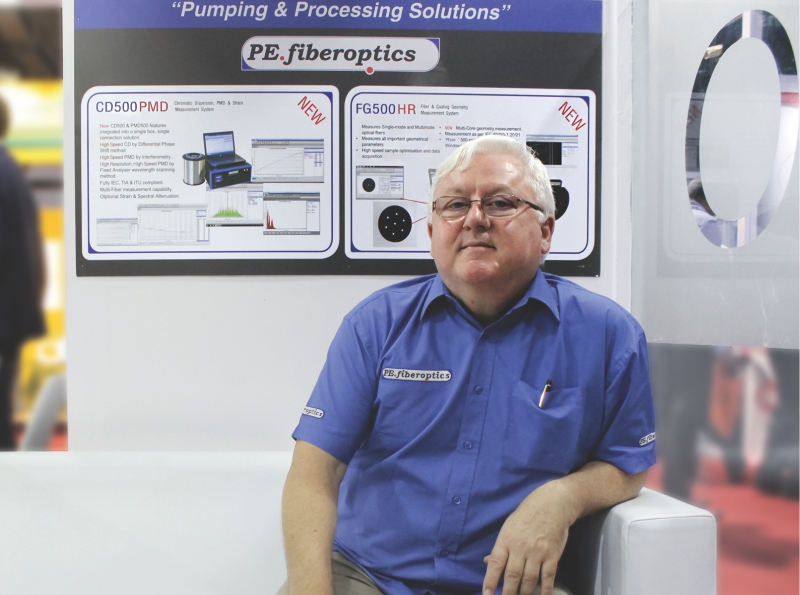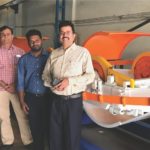The British company, widely regarded as a leader in optical fiber measurement tools, has so far churned out a comprehensive array of equipment to ensure optic fiber and OFC producers achieve desired optical and physical parameters in their fibers. PE.fiberoptics has been serving some of the biggest names in India and is now developing a new optical time domain reflectometer (OTDR) product, to appear soon on the market.

Wire & Cable India recently had an in-depth discussion with Mr. Andy Nicholas, Sales Director, PE.fiberoptics Ltd. Excerpts:
Wire & Cable India: Briefly tell us about the company and your journey so far?
Andy Nicholas: PE.fiberoptics was founded in 1985, originally named EG&G, part of a bigger American group. I have been working for the company since 1999 but the company has been present on the Indian market since 1986. In 2005, we did a management buyout of the Fiberoptics test equipment division and changed the name to PE.fiberoptics. Our turnover has been steadily growing over the years. In 2012, we brought in new product ranges which were designed from scratch.
In our company, we have a large proportion of university graduates with knowledge in different technology areas. We claim to be the market leader in several of our measurement technologies. PE.fiberoptics today provides measurement technologies to all fiber cable manufacturers around the world. PE.fiberoptics is trusted by the biggest players in the Indian industry for supplying them with the solutions they require.
We are not a big company but we believe in performing various jobs depending upon what the customer’s needs are. We are a mixed ownership (private/traded) company and are investing in some new products which hopefully will make us more competitive against other major competitors.
WCI: Kindly brief us about the technologies you have for testing and measurement along with the major areas of applications?
AN: Our Company started with the ability to measure very small signal — to be specific optical signal. We have taken that particular capability and molded it into a set of products where the measurement of very low signal is important. Our first product was CD300 which measured chromatic dispersion and polarization mode dispersion (PMD) which are two transmission properties of an optical fiber that limit the bandwidth of the fiber. We have become the number one supplier around the world for that particular product range and have significant technical advantages over other suppliers in the industry for this type of measurement. This has enabled us to build a pretty big and strong base of faithful customers based upon that one product alone.
Based on that product, we have developed various equipment for measuring different optical and physical properties of the optical fiber, for example, attenuation/loss in fiber (how much signal is lost along its length), etc. We can measure as mentioned earlier the chromatic dispersion and PMD which degrade bandwidth. The coating material diameter as well as the thickness of the coating materials can also be measured. We can measure the parameter called ‘cutoff wavelength’ which defines whether a fiber is a single-mode or multi-mode at the operating wavelength.
We are developing some new products which we haven’t been making in the past. Our competitors are already manufacturing these products but we are working to develop them at a lower cost and better performance compared to our competitions. In particular we are developing an optical time domain reflectometer (OTDR) product– this is a system that can measure the spatial characteristics of the attenuation along the length of the fiber and can be done at multiple wavelengths and from that you can predict a lot of different parameters in the fiber. We have been investing in this project for about a year now and we expect to be showing key customers this new product within about three months.
WCI: Tell us the importance to ensure the perfect optical and physical properties in order to get the best out of an optical fiber?
AN: The fundamental property of an optical fiber is its physical size. The diameter of fiber is very tightly controlled and it is critical for the installer and the telecom operator. There will be problems in joining the fibers if the diameters are not similar and extra losses will be incurred while joining them. The optical fiber manufacturers strive to keep the diameter very close to 125 microns and try to achieve the same within 100 nanometers. If you get much further away then that you start to see losses in the joints. Getting a diameter within the 100 nanometers of the target diameter is not an easy job and that’s really down to the fiber maker to fine tune the technology itself. What we are providing is the ability to measure the results of manufacturer’s process and enabling them to feed back into the process in order to achieve the specification.
The next important parameter would be the cutoff. This is probably the one parameter where you get most scrap in the process. Most failures in the fiber come from the cutoff measurement. This measurement ensures that in the operating wavelength you don’t have more than a single mode of light and that’s where the word single mode comes from. Since different modes travel at different speeds, in a multi-mode condition, modes/beams will arrive at the detector at different times and will corrupt the data.
We have other parameters like mode field diameter, where beam of light or the mode will have a diameter. It is an electrical diameter not a physical diameter. You need to measure an electrical field travelling in the fiber and we do that with a special piece of equipment that enables us to detect the light which is exiting the fiber at different angles. Measuring the distribution of those different angles, we can calculate mode field diameter of the fiber. Keeping that mode field diameter within limit is also important because even if the fiber is perfect in terms of its physical diameter and clarity, you will get a loss when joining fibers with differing mode field diameters.
If we have got a fiber where we have verified that its diameter is correct, it is single-mode, it is easy to join because of the mode fields matching, and its bandwidth is big enough based on CD and PMD measurements, only then will we want to put it into a cable. The cable has only one function to provide, i.e. mechanical protection to the fiber when you install and operate it.
WCI: Who do use your measurement and testing equipment – cable manufacturers or optical fiber producers?
AN: We are serving both cable manufacturers and the optical fiber producers. When the spools of fiber are coming out of the pulling towers into the test room, we are there in the quality control lab in a fiber plant. We provide the measurement and data which is then used to feed back into the process in order to refine the properties as per specifications.
We are also present in the cable manufacturing unit but it is different here because the cable facility is buying the fiber which has already been tested. In reality, the cable manufacturing unit does not need to test everything as lots of fiber properties are frozen into the fiber and cannot change. So there are certain properties that don’t need a retest. However, it really depends upon their customer whether they have to test it or not. Properties like the diameter, which has already been tested by the manufacturer, does not require retesting at the cable plant. Very often, they do retest it in case their customers wish to confirm the specifications.
WCI: Let’s talk about the new product OTDR you were mentioning earlier. What newness are you creating in your OTDR compared to ones existing in the market?
AN: Currently, optical fiber producers use OTDR to check the attenuation along the length of the fiber. The equipment can check how uniform the attenuation is and can check it at different wavelengths. By doing so, it can predict the attenuation and the loss of other wavelengths that were not measured. The problem is there is only one supplier of that product at the moment, and this means there is a monopolistic situation. The prices are very high and there is no incentive for the incumbent supplier to make improvements. So, we have decided that we are going to manufacture this product as well. We are developing it and we are quite a long way down that development process now.
We are targeting to make our OTDR a more affordable product for the fiber producer. The product would be engineered to be very fast to swiftly measure multiple wavelengths. The target is to have all the measurements done on the fiber within a few seconds. One OTDR measurement will typically take 2-3 seconds and 10-15 seconds in total for 5-6 wavelengths. If you couple that with a lower purchase price, then you are going to find a lot of customers very happy that they now have a choice of product for the measurement.
In addition, we are also targeting the new generation of optic fiber producers, who are looking forward to produce longer spools. If you have longer spools, you can produce fewer spools for the same volume of product, which means you have less testing to do. However, the problem is that with longer spools (above 50 km) you need high performance equipment. Our OTDR is being developed to cater to testing needs of spools up to 100 km.
WCI: How much time will your OTDR take to be available in the market?
AN: We expect that by mid-2019 we will be showing our product to the fiber makers around the world. We are already in discussions with certain major fiber makers about what we call beta testing of the product. They will be assisting us by giving feedback and their opinion on the performance of the product.
WCI: How long have you been in India? Tell us about some of the experiences here.
AN: I have been coming to India since 1984 and have experienced how optical fiber and optical fiber cable production has developed over the 34 years now. The market has changed a lot but the mindset has not changed. Here it is still a desire — we want to make in India and make it better in India — and it has always been the case from beginning until now. Some companies have succeeded in achieving this and have been doing quite a good job at this. However, in order to achieve self-reliance in manufacturing you still need external technologies as you cannot have all the technologies built in one single country and you couldn’t possibly exist if you tried to do that.
Certain technologies are held by certain people at certain businesses and they distribute that technology around by way of either a product or a technology transfer. India seems to have the skills and desire to take up those technologies and work on them.
WCI: In fiber optics domain, tell us few companies which are really doing good as what you said in terms of quality.
AN: India is importing but it does have some major plants like Sterlite, Birla Cable Ltd., Corning, Aksh Fiber Optics, Finolex Cables and others. These are some of the companies that are investing and growing. My advice to all these companies is not to grow too fast. They must track the market and plan everything properly. The year 2001 is a good example when everybody was expanding their business but then suddenly the market disappeared.
China Telecom and China Unicom have been planning a tender for 5G, somewhat delayed, so there has been a small braking affect on the market. However, 5G will surely come, now or 2-3 years later, and it will be the driver of the next production boom in optical fibers.
WCI: You mentioned that the desire to produce better quality fiber optic was there from the beginning in India. How do you see the quality adherence practices in India as compared to other parts of the world?
AN: There has been a mindset to buy something based upon price not upon the technology or the quality and this has mainly been driven by the larger cable buyers. To a certain extent that still exists and this forces the fiber and cable manufacturers to cut expenditure on capital goods in an attempt to improve margins. This mindset tends to result in productivity improving technology and practices being ignored in favor of the short term benefits of cheaper equipment. One area that isn’t being ignored at some plants is pulling tower height. If you make it higher, you can pull the fibers faster and produce more for almost the same investment in the equipment. You achieve better productivity than the other manufacturing plants. In terms of testing, longer spools and faster testing equipment facilitates better productivity. Additional automation helps in reducing the employment of workforce in the plant and therefore lowers the cost.
The biggest driver is the Indian population, the customer. If they are willing to pay for something, then telephone companies are willing to invest in the network. If they are willing to invest in the network, the manufacturers are willing to invest in the manufacturing. I think at the moment what’s happening is the telecom companies don’t want to pay top dollar for a product. When you use a tendering system that forces the lowest price bidder to be the winner, you run the risk of manufacturers taking shortcuts in quality control. The ability to make good quality product is already there with good quality control. But if your margins are being squeezed by the tenders, then there is always the chance that people will make choices that will affect quality.
WCI: Share your opinion on the growth of the Indian wire and cable market as a whole. How PE.fiberoptics is prepared to cater to the growing demand in the coming years?
AN: The wire and cable industry in India has gone through several different phases of expansion and contraction. You might remember the jelly-filled telephone cables market; everybody including the big plants invested in it but now they are all gone. JFTC is now being used no more for the telephone lines. That was an example of boom and bust cycle. One time it was big and then it is gone. Fiber optic cable will have its boom and bust period; it had one 17 years ago and it will have one again.
India will have consolidation of certain plants and closure of certain others but there will be an ongoing market for fiber optic cables. The industry as far as I know and as long as I have been in it has had a cyclical demand profile where demand is based upon the economy and technology. The technology and economy run at different speeds and so sometimes these peaks and troughs in the two different demand cycles coincide and you either get a boom or you get a bust and at other times you just get a steady trickle of business. We, along with some players in India have survived through all of that and the people who are still here are the ones who know how to manage and survive it.
I think the next two or three years, we will still see some good growth in the cable industry, especially the fiber optics. The cable industry is generally driven by whatever the population is doing. If you are building new houses, you will need cables. This way cable industry will always be tracking the fundamental economy.
The fiber optic market is really tracking people’s spending habits. How the general population is receiving their entertainment, their communication. People are going to convert to 5G, they will be streaming television and this requires fiber. I think India cannot produce enough fiber at the moment to satisfy the demand that will come over the next 2-3 years. This is the reason why the major fiber makers in India are investing a lot to expand production to produce the fiber that will be needed over the next 2-3 years.
India stands to be in a good position globally in terms of being a producer of these products. Once you have saturated your own market with cable there will still be a market for replacement. There will be some additions but you will find other markets which need it and those become your export market.
If you have technology and the production in place, then you can export to Africa. The African countries are the next big and growing markets. China is covering its domestic market. The Middle East will grow but the small population may impact the scope for business there.
WCI: Any final words on behalf of the PE.fiberoptics?
AN: I would advise the Indian customers to continue investing. We make profit when your business is thriving. Everyone makes money when everyone is investing. We will continue investing in our product development which will enable our Indian customers to benefit from these new technologies that we are going to bring forward to help them with productivity and quality. PE.fiberoptics is here for the long term in the market and we are not a fly-by-night company. All our Indian customers recognize our commitment to this market. Even when there are no orders, we still support the market.




